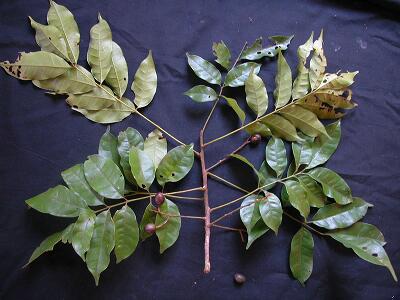Anacardiaceae
Tapirira guianensis Aubl.

Kingdom: Plantae Rank: Species Parent: Tapirira Status: Valid
Morphological Description
Diagnosis: Shrubs or trees to 30 m tall. Leaves alternate, compound, the leaflets opposite with asymmetric bases. Inflorescence axillary panicles or sometimes spikes. Flowers tiny, 5-merous, white to cream-white. Fruit a drupe, ellipsoid, purple to black when mature. Seed one per fruit. A highly variable species found in forest and swamp habitat in the study region.
Vegetative Morphology
Habit: Shrubs and trees to 30 m tall, growth stunted to shrub when growing in Mauritia-dominated wetlands.
Main axis: Trunk cylindrical with characteristic small buttress roots at base.
Leaves: Leaves imparipinnately compound, alternate, to ca. 30 cm long; leaflets opposite; petiolules to ca. 1 cm long; lamina elliptic to obovate, to ca. 10 x 15 cm, chartaceous to coriaceous, the base acute to weakly asymmetric, the apex rounded to short-acuminate, the margins entire, the secondary venation somewhat brochidodromous.
Reproductive Morphology
Inflorescence: Inflorescence a panicle or sometimes a spike, axillary.
Flowers: Flowers tiny, actinomorphic; sepals 5, brown to green; petals 5, white; stamens usually 10, free; ovary superior, stigmas usually 5.
Fruit: Fruit a drupe, globose to ellipsoid, to 1.5 cm long, purple to purple-black when mature.
Seeds: Seeds one per fruit.
Other
Notes: A highly variable species complex found in forest and swamp habitat in the study region.